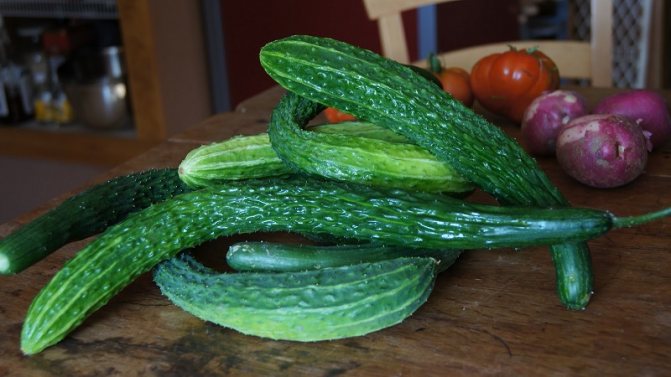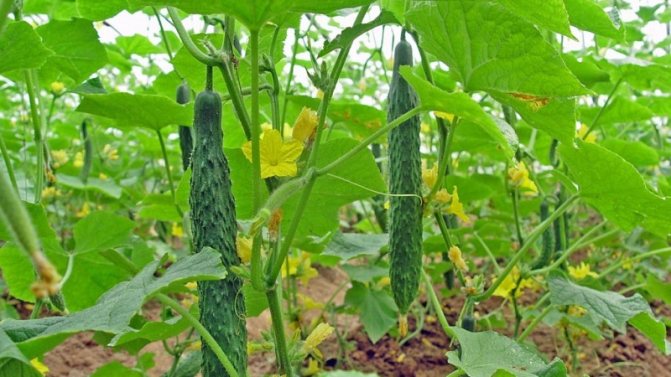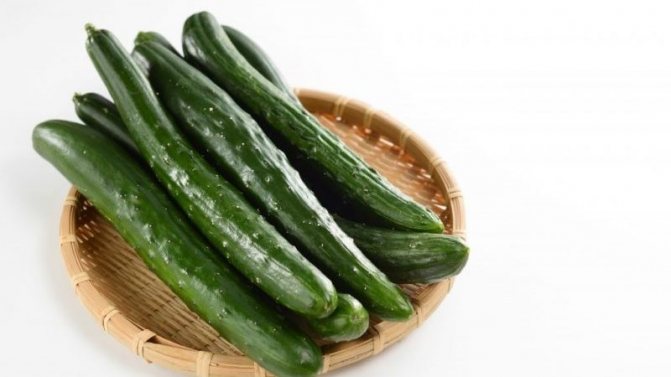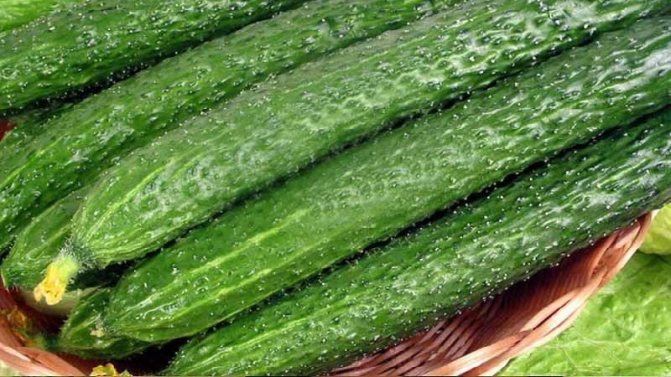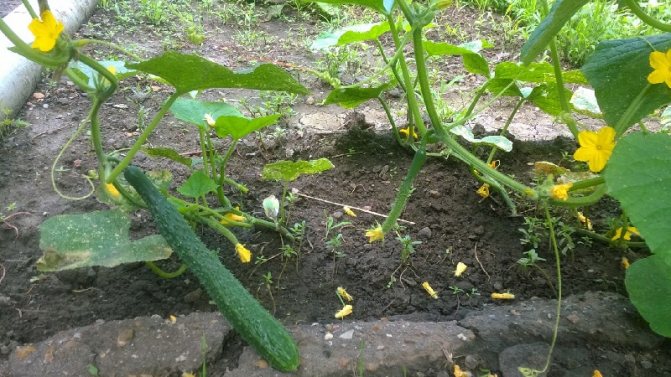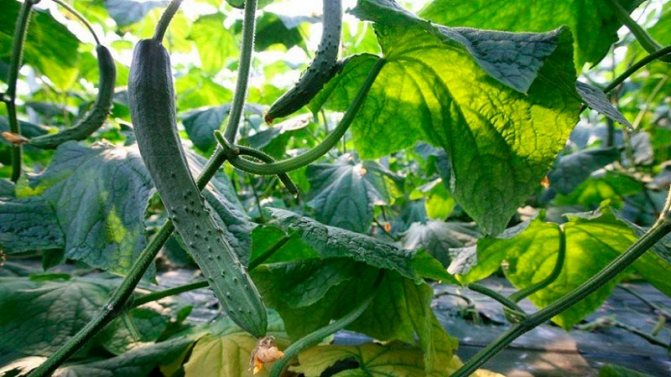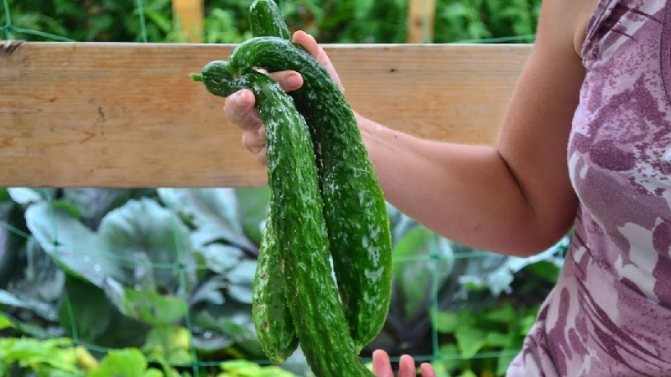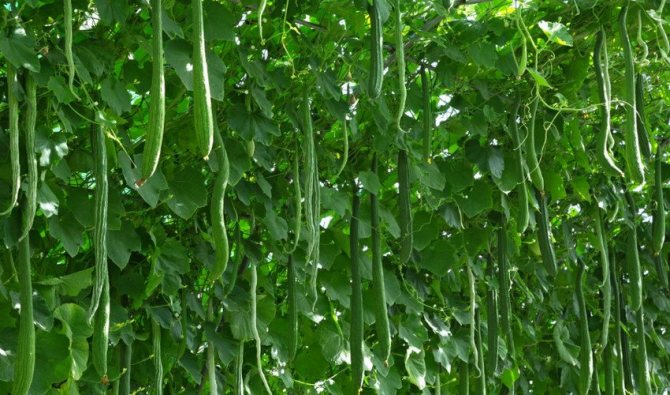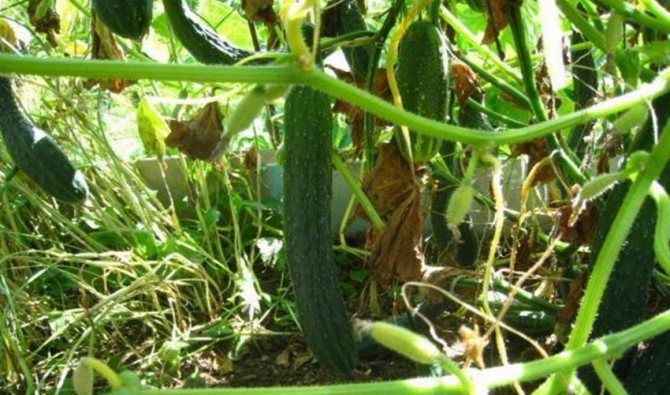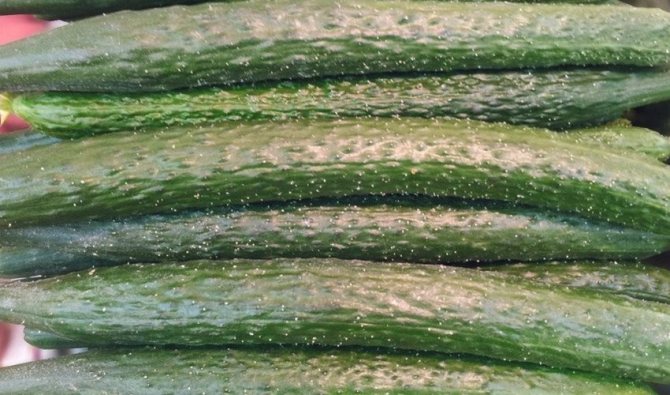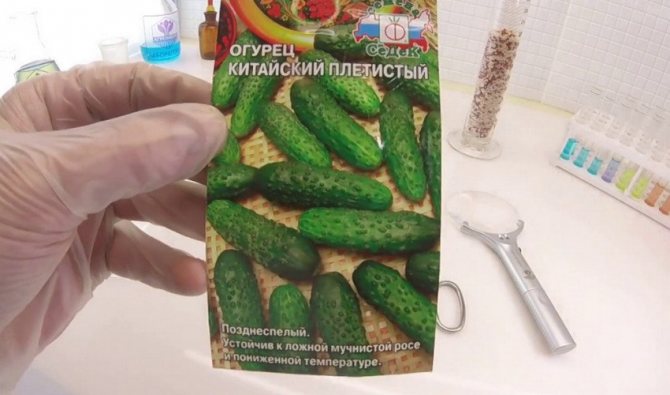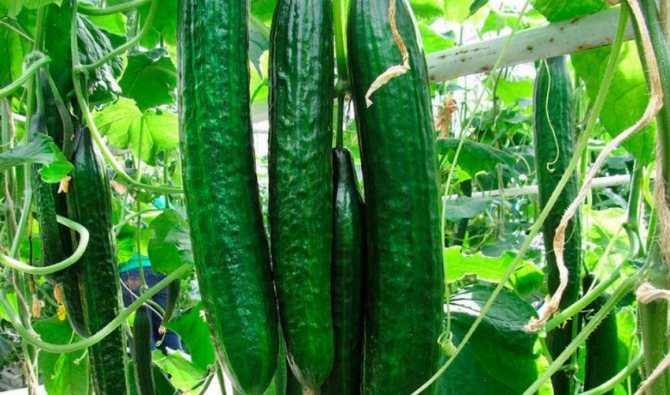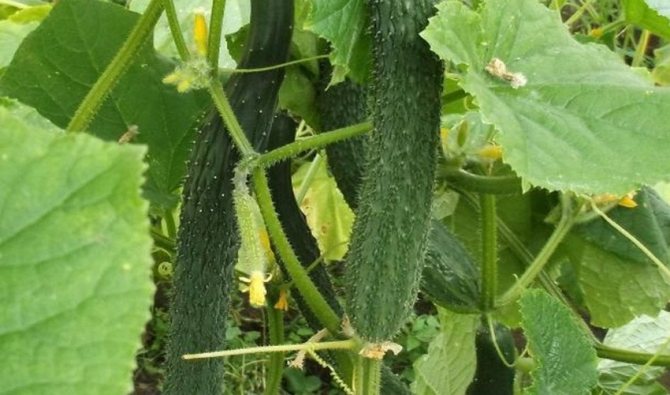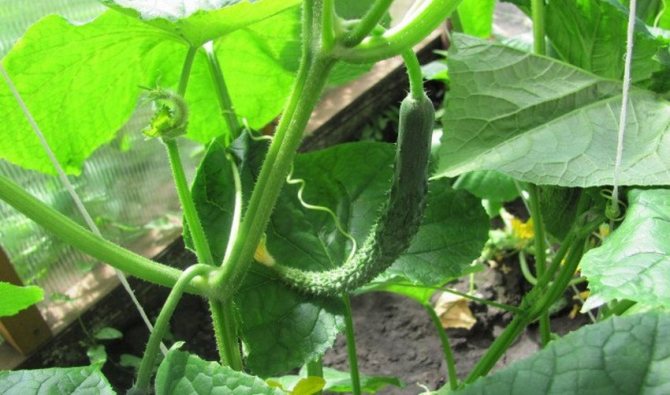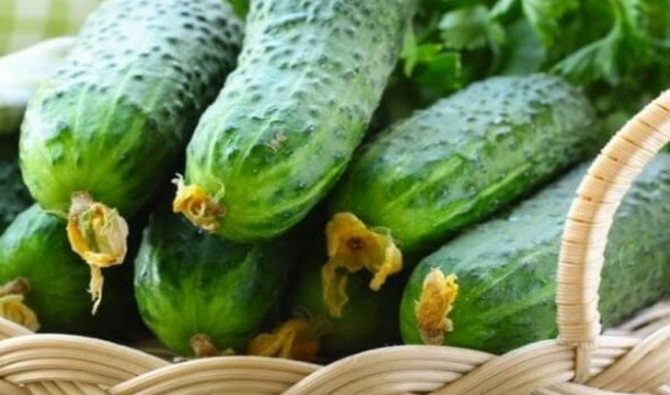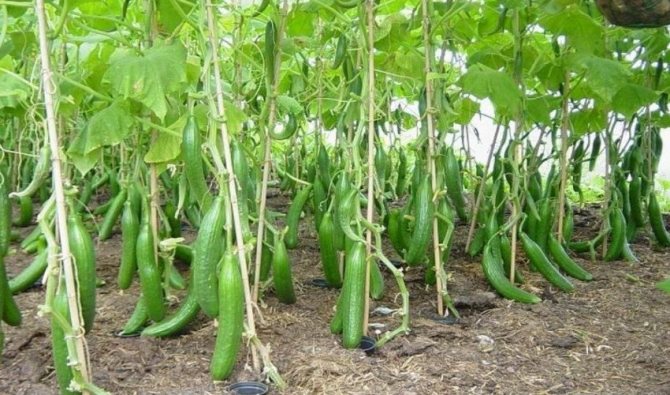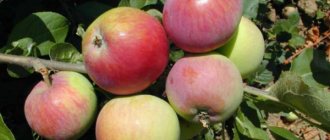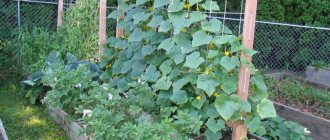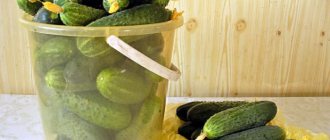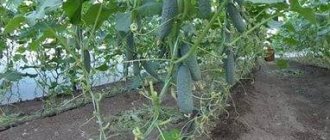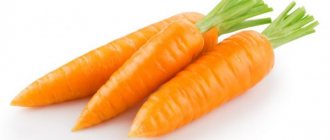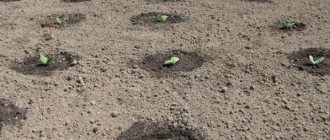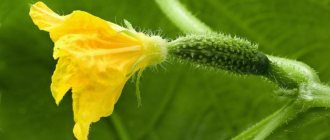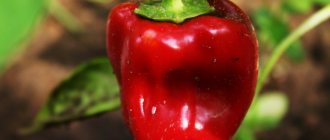Description and features of Chinese cucumber
Chinese cucumber is a special type of plant from the Pumpkin family. It was bred in China, differs in:
- long-fruited (fruits stretch 80-90 cm in length);
- interesting, unusual taste and aroma (some varieties smell like a melon or watermelon, the pulp is sweet);
- lack of voids inside the fetus.
Outwardly, a Chinese cucumber is no different from an ordinary one, it is only given out by its length. The color of the fruit depends on the specific hybrid. There are cucumbers with light and dark skin.
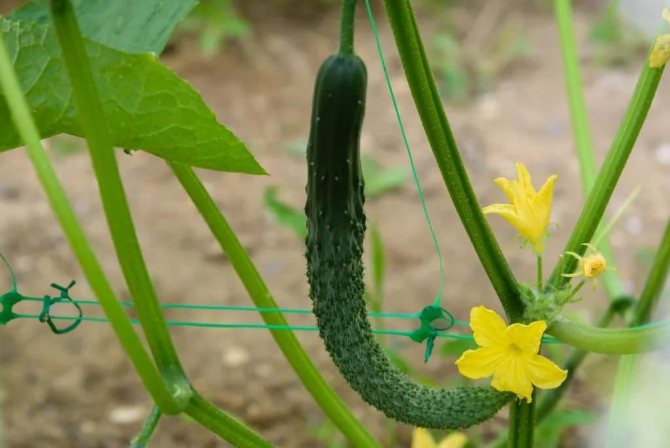
Farm cucumber
Important! Cucumbers with light thorns are best for salads, and fruits with dark thorns are best for preservation (pickling, pickling).
Diseases and pests
For the purpose of prevention, plants are treated with fungicides in compliance with the norms specified in the instructions.
Major diseases:
- powdery mildew;
- anthracnose;
- mosaic;
- angular leaf spot.
Powdery mildew appears as white spots on the leaves. It is treated with colloidal sulfur. Anthracnose is disposed of with a solution of copper oxychloride. The mosaic cannot be cured; the plants will have to be destroyed. Bordeaux liquid is used for leaf spot.
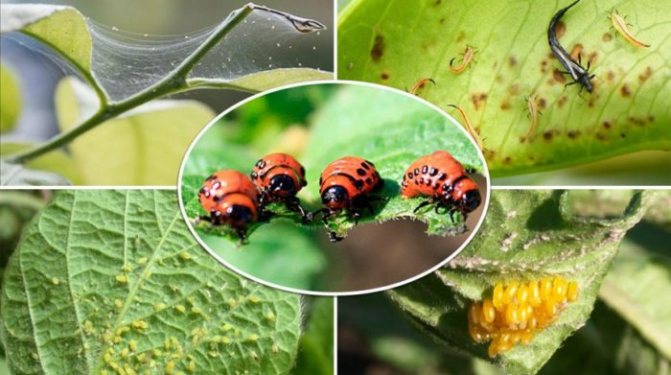

Sometimes plants are attacked by such pests as spider mites, melon aphids and whiteflies. Treatment with Fitoferm, Phosbecid is recommended. Laundry soap will help to cope with aphids. Fortunately, Chinese cucumbers rarely succumb to disease.
Advantages and disadvantages
Growing Chinese cucumber has certain advantages. For example, a large bowl of lettuce can be obtained from just one fruit.
Experienced vegetable growers refer to the positive aspects of sowing seeds of this particular culture:
- lack of bitterness (skin and pulp retain sweetness at any stage of growth);
- undemanding to growing conditions (cucumbers can grow in the shade, withstand an increase in air temperature up to +40 degrees);
- endurance (diseases and pests are almost not terrible for Chinese cucumber);
- yield (with proper care, up to 30 kg of fruits are harvested from one bush).
The disadvantages of this cucumber crop are noted mainly by those who grow vegetables for sale, as follows:
- seeds do not germinate well, you have to transplant or use special growth-stimulating substances;
- the fruits on the second day of storage begin to wither, become soft, they need to be consumed or rolled up immediately after collection;
- most of the varieties are intended for salads, universal and those that are suitable for preservation, much less;
- cucumbers must be tied up;
- if the lashes stretch along the ground, the fruits twist, lose their attractive presentation;
- some varieties have thorny thorns, do not tolerate temperature changes.
A Chinese cucumber is not easy to grow for a gardener who does not know anything about such a variety, mistakes cannot be avoided.
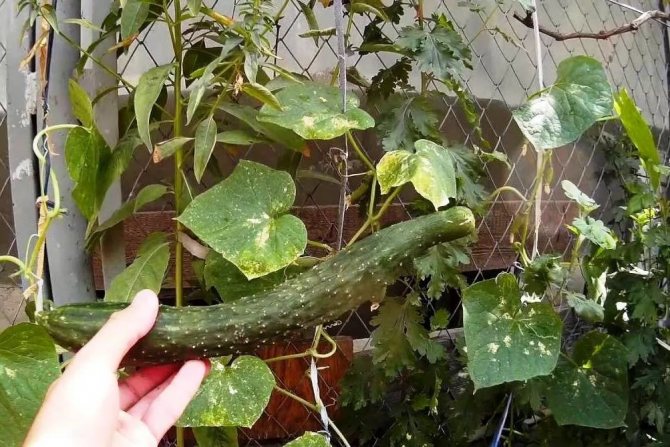

White thorn cucumber
Reviews of gardeners
Even despite the fact that the Chinese cucumber belongs to an exotic culture, every day it wins back its meters from ordinary cucumbers, which is reflected in the reviews.
Tamara, amateur gardener, Krasnodar Territory: “Chinese cucumbers were advised in the store - they promised that they would like them. Oddly enough, they did not lie. I planted them in July, 80% of the crops had risen in a week. It is very hot here in summer - up to 40 degrees in the shade, so the heat resistance of the variety is very useful.Ordinary cucumbers disappear, wither and dry, but Chinese ones at least. Cucumbers grow up to 45 cm, there are few seeds ”.
Veniamin, summer resident, Vladimir region: "I plant Chinese cucumbers with seedlings. Seeds sprout poorly in the ground. I pinch the lashes when they grow to the trellises. The variety practically does not branch out to the sides, so they are densely planted. The taste is excellent and it never tastes bitter, even if it's very hot outside. For a long time, the question was haunted: why do Chinese cucumbers grow in a crochet and curl? I read that it happens because of a lack of potassium, fed it - even fruits went. "
Natalia K., 40 years old, summer resident, Moscow region: “Last year I drew attention to the Chinese disease-resistant variety. I bought it! Those that were planted directly into the ground sprouted better than the usual soaked ones. On the third day, instead of flowers, such long, good ovaries of these cucumbers appeared in the greenhouse. Two more days passed and huge cucumbers grew in their place! During growth and fruiting, I did not notice any signs of disease! So I didn't have to spray them with anything, and they grew as they are, on unfertilized ground, and grew half a meter in length and weighing half a kilo! In a greenhouse, planting and maintenance does not require any difficulties. The result of these seeds suited me, I bought them again, and I will grow them again! The cost also allows! "
Types and varieties of Chinese cucumbers
Each variety of Chinese cucumber is special, and many hybrids have also been bred, which cannot always be recognized by the length of the fruit.
The most popular varieties are:
- Alligator F1. An early ripe variety, cucumbers appear on the ovaries 45 days after planting seedlings in open ground. The fruits stretch 40 cm in length. They are soft, juicy and sweet, have an elongated cylindrical shape. The plant needs a garter (lash length 2.5-3 m) and pollination.
- White delicacy. A variety with an average ripening period (50-55 days). Fruits are conical, elongated, the skin is sometimes light green, but more often white, bumpy or covered with thorns. Length, like an average cucumber, 12-15 cm. Needs pollination by bees.
- Chinese snakes. Salad variety of cucumbers. Ripens early, 35 days after planting. Fruits with light skin, long (50 cm or more), arched, covered with minor pimples. Not pollinated on its own.
- Flameproof. The variety is classified as medium early, the first crop is harvested 50 days after planting. Cucumbers are long, even, dark green, up to 45-50 cm long. It is pollinated on its own, therefore it is ideal for growing in a greenhouse.
Where is it recommended to grow a crop
Cucumber culture loves vertical placement. If it is possible to provide such cultivation in the open field, then it is worth using it, if not, then it is better to grow in a greenhouse. To get an early harvest of vegetables, it is recommended that the Chinese be placed in a greenhouse. In this case, absolutely even, long cucumbers are obtained.
Many gardeners, according to their abilities, grow giants cucumbers on the street. The beds are placed directly on the soil. Then the cucumbers will have a fancy shape, but the taste will not deteriorate.
Greenhouse maintenance allows the plant to provide more optimal growing conditions than in the open field.
Unstable weather, hot day and cold night, frequent incessant rains, all this will negatively affect the flowering, ovary and ripening of cucumbers. Therefore, the best option is a greenhouse with a polycarbonate or glass cover. If not available, cucumbers can be placed in a greenhouse, but the size of the greenhouse does not allow growing vegetables vertically.
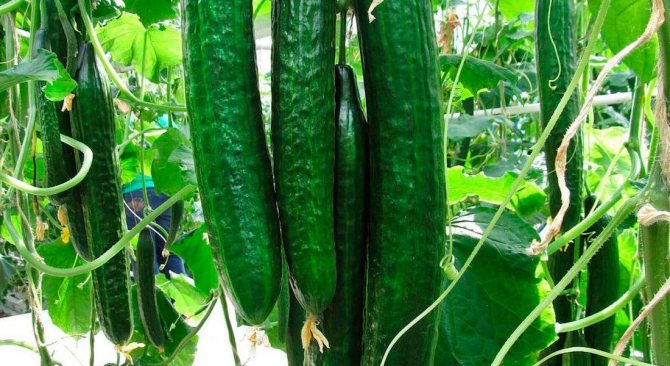

Features of growing and care
Chinese cucumbers need careful grooming. Particular attention is paid to germinating seeds and looking after seedlings.
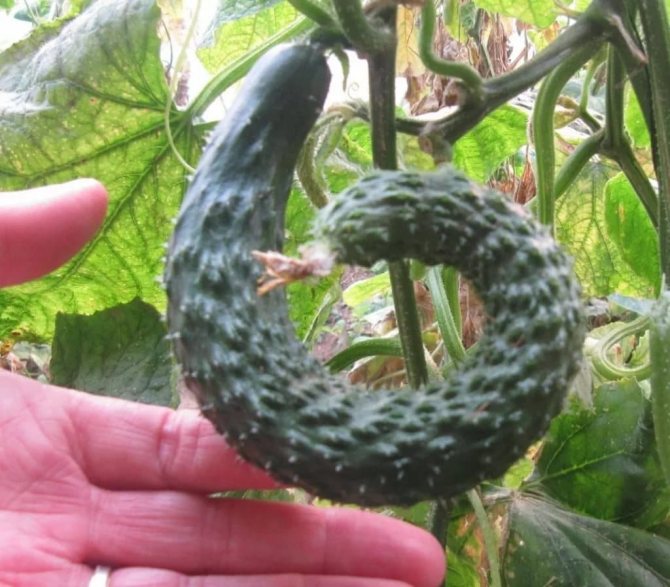

Serpentine variety
Growing seedlings
Seedlings are grown in containers or pots, planted in the ground 1 month after sowing. Much depends on the size of the container as well as the composition of the soil. Chinese cucumbers grow faster if they use a mixture of:
- peat (6 parts);
- sand (1 part);
- birch sawdust (1 part);
- humus (2 parts).
If the seedlings are grown directly in the open field, then compost, peat and red-ripened soil taken from the forest must be added to the soil. Be sure to feed with superphosphate (15 g) and ash (300 g). The use of nitrogenous fertilizers is recommended only before flowering.
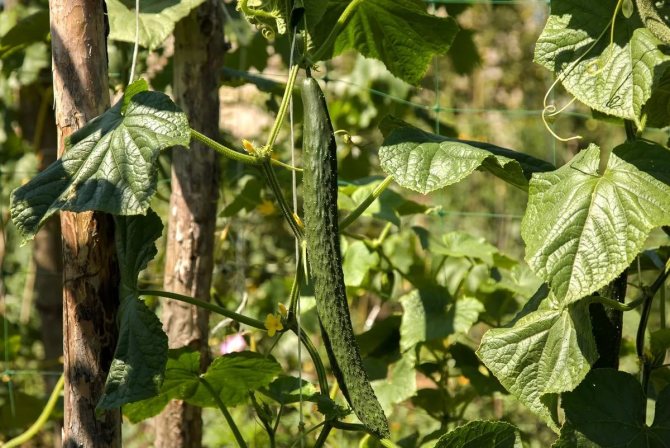

Tied cucumber
Seedlings are planted:
- at a distance of 20-30 cm from each other;
- into the wells previously spilled with a solution of potassium permanganate (for disinfection) and water;
- into the soil so that the root collar is located at a distance of 2 cm from the top soil layer.
When transplanting seedlings from a glass into the soil, they try to do it carefully so as not to damage the roots.
For reference! Disembarkation begins as soon as the daytime air temperature reaches +15 .. + 20 degrees.
Seed planting
Chinese cucumber seeds do not germinate well, so before sowing them:
- calibrate, for which they put it in water, wait 30-40 minutes and remove those that have surfaced (they are not viable);
- pickle (soak for 1 hour in a solution of potassium permanganate);
- placed in a growth stimulant;
- germinate within 3 weeks.
In open ground, seeds are sown when the air temperature is kept at +12 .. + 15 degrees.
For this:
- make shallow holes;
- 3-4 seeds are buried in each hole at a depth of 3-4 cm.
After the emergence of seedlings, they are thinned out, removing excess ones. Thinning is done twice, the first time leaving a distance of 10 cm between the individual shoots, and the second time - at least 20-30 cm.
Important! When thinning, excess shoots must not be abruptly pulled out, so as not to damage the roots of neighboring shoots. They are plucked out or cut with scissors.
Watering
The regularity and intensity of watering depends on the method of planting. Greenhouse cucumbers are watered 2 times a week, vegetables growing in the open field - depending on the weather. If it's hot, water it every day.
Up to 0.5 liters of water are poured under the seedlings; 1-1.5 liters of water is enough to saturate large, overgrown bushes.
For irrigation, they take exceptionally warm, settled water.
Systematic feeding
During the season, cucumbers are fed 2 times. The first time before flowering, about 2 weeks after sowing seeds or planting seedlings, and the second, when fruiting. To stimulate the formation of ovaries, use a solution of:
- boric acid, potassium permanganate, iron and copper sulfate, urea at the rate of 1: 1: 1: 3: 100 g (urea is diluted in water, acid is diluted, mixed with the rest of the ingredients, and then the bushes are sprayed);
- cowshed and water at the rate of 1:10 l;
- chicken droppings and water (0.7 liters of droppings and 10 liters of water);
- ash (100 g of ash is dissolved in 10 l of water).
What does a Chinese miracle vegetable look like?
In appearance, this type of cucumber is very similar to the usual one we are used to. But the "Chinese" also has a number of features. First, it is much longer than its Russian counterpart. Ripe fruit can reach 80 cm.
Secondly, it is distinguished by an unusual sweetish taste and fresh aroma, reminiscent of watermelon or melon. Compared to ordinary vegetables, this vegetable does not taste bitter when properly grown, its rind is sweeter, and its flesh is denser. Small seeds are collected in Chinese cucumber.


Chinese cucumber is much longer than its regular counterpart.
Advantages and disadvantages
Undoubtedly, the advantage of a long cucumber is its resistance to major diseases, as well as early maturity. From the moment of germination to the first harvest, a little more than a month passes, depending on the selected variety.You will also be surprised by the number of fruits, because just from a bush you can make a salad for a whole family! Now you do not need to plant the entire garden with cucumbers alone, only 4 plants are enough to get a full harvest.
But the Chinese cucumber also has its drawbacks. First, it deteriorates quickly. After lying only a day from the moment of removal, the fetus becomes soft. In addition, not all varieties of "Chinese" are suitable for harvesting, some are suitable only for consumption raw, in salads. In addition, the seeds often do not germinate well, and the culture requires a mandatory garter, otherwise the fruits grow ugly and bent.
Harvesting
To get a solid harvest, strong sprouts dive in the cups. Fruits are harvested at least once every 4 days.
A feature of Chinese cucumbers is the absence of yellowness on old fruits. The seeds do not coarse or harden. If you plan to stock up on vegetables for the winter, then preservation is done immediately after harvesting.
For reference! According to the reviews of Russian gardeners, it is better to salt and pickle cucumbers of the Chinese Miracle variety.
How to grow
The rules for the cultivation of Chinese cucumbers are not much different from the cultivation of conventional varieties and hybrids. Suitable both for growing in greenhouses and in the garden.
Features of growing in a greenhouse and open field
The main feature when growing all Chinese varieties and hybrids in the greenhouse and in the open field will be the obligatory tying on strong trellises. This will help to get straight fruits, without kinks.
The culture is planted closer to each other, which saves space, but do not forget about the height of the stems when choosing a greenhouse.
The best varieties of Chinese cucumbers
Before buying seedlings or seeds, they are determined with a variety. If the conditional fontanel can be used both for salad and for preservation, then universal varieties are rarely found among Chinese cucumbers.
Chinese miracle
The Chinese miracle is one of the late varieties, ripens 70 days after sowing seeds or planting seedlings. Cucumbers are dark green, cylindrical, sometimes curved, stretching 45 cm in length. The variety does not need pollination by bees.
A high-yielding variety, due to regular feeding, timely pinching, tying and watering, up to 25-30 kg are harvested from the bush. Forms ovaries and bears fruit until the first frost, suitable for conservation.
Chinese farm
A hybrid variety, the fruits are formed already 50-54 days after planting. The length of the cucumbers is 40-45 cm, up to 35 kg are harvested from the bush. Suitable for salads and preserves. In this case, they are cut into slices.
There is no bitterness and voids inside the pulp, it is soft, juicy, pleasant to the taste, never bitter.
Chinese emperor
An early hybrid variety with a maturing period of 42-45 days. The yield is high, 25-30 kg per bush. It is imperative to tie up the bushes, because the lashes are extended by 3-3.5 m.
Fruits grow up to 40-45 cm, they are dark green, sometimes watery.
It is resistant to powdery mildew.
Chinese funny moths
A hybrid of several varieties. Withstands high temperatures, can grow even in the open sun. Refers to the early maturing.
Suitable for pickling and salads. If the cucumbers are not picked in time, they do not overripe, do not turn yellow.
Chinese cucumbers are ideal for those who live in hot regions. They grow outdoors and in greenhouses, and have unusual fruit lengths (50-80 cm). The vegetable is disease-resistant. It's easy to look after, the only difficulty is finding trellises and suitable support.
‘Chinese sticks F1’
High-yielding parthenocarpic hybrid '
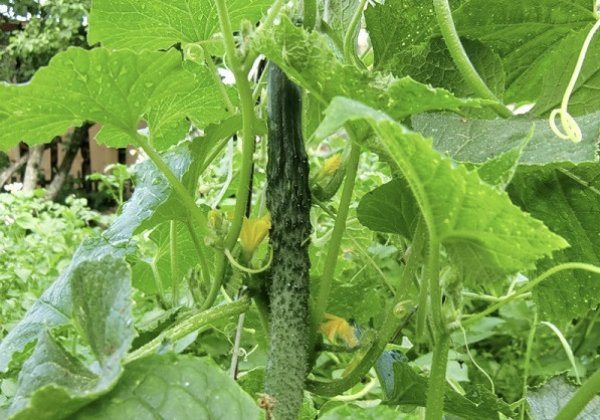

’Suitable for open and protected ground. Enters fruiting early: 45-48 days after germination, the first crop can be removed. Growing this hybrid, you will appreciate the excellent quality of its fruits - sweet, with a rich fresh cucumber aroma, thin skin and juicy pulp.
Cucumber ‘Chinese sticks F1’
Ideal for light summer salads and sandwiches. The hybrid is characterized by increased resistance to cladosporiosis, cucumber mosaic virus, and downy mildew.
'Dark Night F1'
Pay attention to the gourmet salad novelty - hybrid ‘
’.The fast-growing parthenocarpic will give its first fruits in 38-40 days from germination. Suitable for growing both in the open field (in the south) and in greenhouses (in the middle lane).
Cucumber 'Dark Night F1'
Do not thicken the planting, a vigorous plant will be comfortable in 2-3 pieces. for 1 m². He will also need a garter to the trellis, regular watering and feeding. But the hybrid is worth it, believe me! He does not care about heat, low above zero temperatures and slight shading, he is practically immune to diseases of pumpkin crops.

